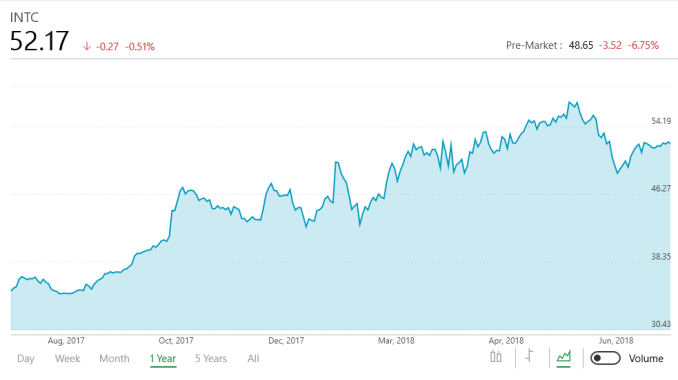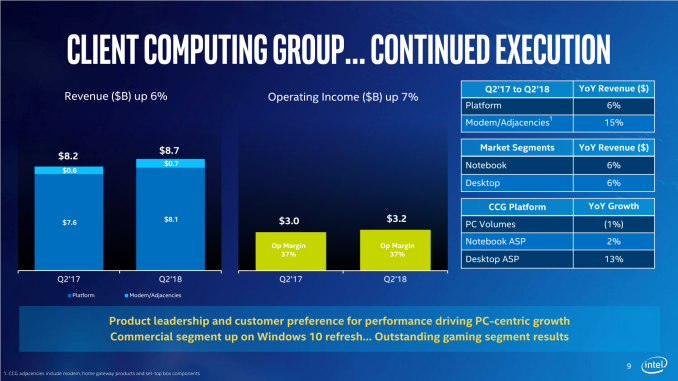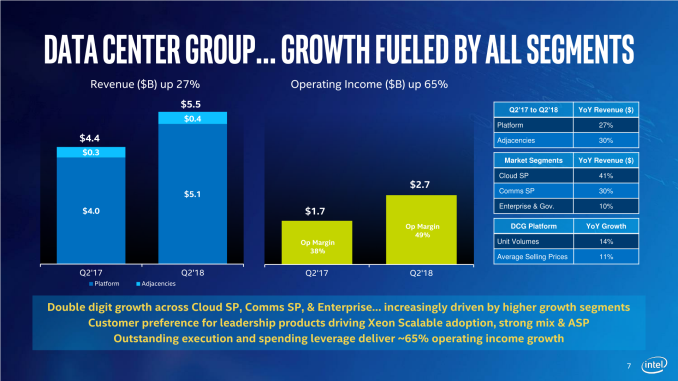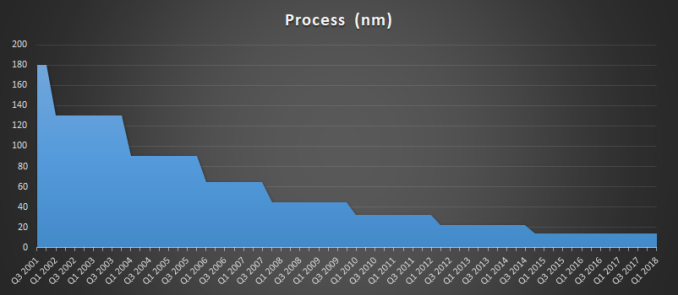Intel Announces Q2 2018 Results: Setting More Records
by Ryan Smith on July 27, 2018 9:00 AM EST- Posted in
- CPUs
- Intel
- Xeon
- Financial Results

All across the hardware industry 2018 is shaping up to be a banner year for earnings, and the 800lb gorilla that is Intel is no exception. Reporting their Q2’2018 earnings yesterday afternoon, Intel booked $17.0B in revenue for the quarter, setting another new Q2 revenue record for the company. Meanwhile net income, while not being noted as a record for the company, was still very high at $5.0B. This puts Intel well ahead of itself both on a year-over-year and sequential basis, topping Q1’2018 and Q2’2017, both of which were also record quarters. All told, Intel’s both Intel’s revenue and net income for the quarter increased by $2.2B year-over-year, while against Q1 they’re up $0.9B and $0.5 respectively.
Meanwhile Intel’s all-important gross margin has held relatively steady at 61.4%, which is down two-tenths from Q2’2017, but up from the previous quarter.
| Intel Q2 2018 Financial Results (GAAP) | |||||
| Q2'2018 | Q1'2018 | Q1'2017 | |||
| Revenue | $17.0B | $16.1B | $14.8B | ||
| Operating Income | $5.3B | $4.5B | $3.8B | ||
| Net Income | $5.0B | $4.5B | $2.8B | ||
| Gross Margin | 61.4% | 60.6% | 61.6% | ||
| Client Computing Group Revenue | $8.7B | -3% | +6% | ||
| Data Center Group Revenue | $5.5B | +6% | +27% | ||
| Internet of Things Revenue | $880M | +5% | +22% | ||
| Non-Volatile Memory Solutions Group | $1.1B | +10% | +23% | ||
| Programmable Solutions Group | $517M | +4% | +18% | ||
Breaking down the numbers by Intel’s various business groups, all of Intel’s groups saw revenue growth for the year. This ranges from 6% for the client computing group, up to 27% for the data center group. And even on a less-comparable quarterly basis, every group except CCG has seen some growth.
Overall Intel has been making a concentrated effort to pivot towards (or at least play up) what the company sees as the segments primed for growth – which Intel is calling its “data-centric” business – and isolate it from the “PC-centric” client computing group. Looking at revenue growth it’s easy to understand why; client computing revenue has been slow to move for years now, while Intel’s other businesses have grown much faster, and as an added kicker are generally more profitable too. None the less, Intel can’t ignore the fact that the client computing group alone makes up more than half of the company’s revenue. However at the rate things are going, this might be one of the last quarters where that is true.
On the client computing front, Intel is citing the commercial and enthusiast segments as being the driving factors for the growth, which is unsurprising as the two have been consistent performers with higher-than-average spending. Beyond that, Intel hasn’t broken down client computing revenue by form factor or such this quarter, so unfortunately we don’t get any insight into how the recently launched Coffee Lake mobile parts have done.
Besides being a more stagnant space, the biggest challenge Intel faces with the client computing group right now is in fact the company’s biggest challenge, which is the stalled development of their 10nm process. As part of today’s earnings call the company has announced that they are still on-track for 10nm mass production in 2019, however they aren’t expecting complete systems to reach store shelves until the holiday shopping season. Which means Intel will be relying on their 14nm technology and resulting products for the next 12 to 15 months, which is going to make it harder to entice already fickle consumers into upgrading.
The news is of course happier with Intel’s other business, all of which have grown at a much greater rate. Intel continues to sell Xeon processors to server vendors and cloud server providers at a good clip, with revenues there improving by 27% year-over-year. And yet even with that growth, Intel actually missed analyst expectations by 2%, indicating just how hot this business segment really is: there’s clearly still very high demand for server processors. Going forward however, Intel is going to be facing off with AMD and EPYC, which is finally finding its footing. So it will take a lot of work to sustain this growth, especially as according to Intel’s own accidentally published roadmaps, the company won’t have 10nm-class Xeons read until 2020, which means Intel will likely be playing defense against AMD starting in 2019.
The rest of the “data-centric” business is a similar upbeat story. FPGA sales are up, non-volatile memory sales are up, and even IoT sales are up. The reasons are varied, but overall NAND prices have been good and the drive for neural networking hardware is helping sales on both the FPGA (cloud) and IoT (edge) sides.
Overall then, based what has now been two strong quarters of growth for Intel, the company is expecting the rest of the year to go similarly. And indeed at this point they’re expecting 2018 as a whole to be their third consecutive record year. Which is especially impressive at a time where Intel’s core manufacturing advantage has increasingly slipped away. Conversely however, there remains the lingering question of whether Intel can sustain this kind of growth for the next year without their next-generation fabrication technology.
Source: Intel Investor Relations



















27 Comments
View All Comments
zepi - Friday, July 27, 2018 - link
I think that while in theory Intel plays the defence in the server space after Epyc 2, in practice the ramp-up and limited quantities they can produce combined with the long product verification cycles etc. will limit the damage that AMD can cause.For many software vendors testing the SW on EPYC is not an issue, because customers have Intel. And customers can't use EPYC until the software vendors promise support on it. It can take surprisingly long time to break this cycle.
Luckily for AMD epyc is good enough and they can sell it cheap enough, so that there is incentive for datacenter operators to look into it.
dgingeri - Friday, July 27, 2018 - link
The greatest problems AMD has had in the past has been impatient and indecisive management and their board of directors demanding they abandon projects because profit wasn't immediate. Well, that and a severe lack of marketing. It looks like Lisa Su will have this under control for the near future. I hope she can hold onto that control and keep them on track. An unfocused company can do nothing but fail. Short term thinking can do nothing but fail.Microsoft is learning that now. They've been unfocused for years, and have been suffering the consequences. They're just rich enough to not notice for a while.
Targon - Friday, July 27, 2018 - link
The numbers are very different when you compare the consumer space to the server space. So, AMD probably has the capacity to meet ANY demand in the server space, while a huge demand in the consumer space would be met with shortages.FreckledTrout - Sunday, July 29, 2018 - link
Since AMD decided to manufacture EPYC (Zen 2) atTSMC which I assume also means Threadripper, then GloFlo should have quite a bit of extra manufacturing capability.Flunk - Sunday, July 29, 2018 - link
That only applies to a segment of the market. Many companies develop their own software or only run boxed software qualified on a variety of CPUs.My company writes SaS and in C#, we could port the whole thing to ARM if it saved us money, Ryzen vs Core is nothing.
Demigod79 - Friday, July 27, 2018 - link
Great earnings, but that's not what investors are focusing on. INTC is down 8% on delay of new products (10nm process). It looks like AMD's 7nm Zen 2 will be unchallenged for most of 2019.HStewart - Friday, July 27, 2018 - link
You don't really know that Intel has a new line of servers on 14nm that has more memory and other things coming in 2019.HStewart - Friday, July 27, 2018 - link
I think this actually shows that AMD efforts is minimal impact on Intel performance and that most people buy computers still trust Intel. That just claiming you have lower nm rating does not mean that you have a better processor.Of course one thing that people need to understand on forums out - that most people that use Intel products don't care about what is on the internet technically - that purchase based on past history of stable company.
Time will tell but I believe that Intel 10nm process is more dense than competitor's 10 nm and even the 7nm. Also this nm wars and even core wars reminds me of days of frequency wars
I also believe the real issues for most normal people that existing computers are good enough for them and there is no need for upgrade. Realistic how much power do need to run Word processor or spread sheet or PowerPoint.
Targon - Friday, July 27, 2018 - link
The earnings just show that Intel has a huge lock on the industry due to contracts and agreements, but when you hear big corporations are going with AMD in the server space, it also isn't a knee-jerk reaction, they must have tested AMD servers with their software and verified that everything is working as expected.Things to consider: Meltdown/Specter is still a concern for many, and won't be fixed for quite some time, even if software and BIOS updates mitigate the problem. The mindshare for AMD has grown, where most people would not have considered buying an AMD based machine, and these days, you see a LOT of people looking at AMD, looking at Intel, and seeing a real choice. That hasn't been the case for a long time.
The confidence that Intel is the undisputed king of performance and quality has been shaken, and that is why you see Intel shares going down in value. Nothing was reported that would make people think that fixes for the recent problems, the huge delay in 10nm, the lack of anything really game changing from Intel and just the feeling that Intel isn't really in control of the PC chip market all come to mind.
As far as sales, since AMD released Ryzen, it has re-invigorated interest in the computer industry again, so sales are up. Intel marketshare may actually be lower right now, even with the increase in sales, and THAT is what many people have missed.
As far as most people not needing much processor power, they is true, but at the same time, the industry is ruled by "lowest common denominator" for software. People would accept a dual-core processor as long as they have never used a quad-core processor, at which point, they suddenly feel like something is wrong with their computer. Need vs. want. If the prices are not going up but CPU power is, then people will gradually gravitate toward more powerful machines. Once you get to a certain percentage of people having above a given level processor, software will start to demand it. For games, how many of them really pushed to support more than four cores, until 6 and 8 core processors were out there in enough numbers to make developers see a need to really support as many cores as possible? That is the key, and even word processors will end up with more features or doing more as computers become more powerful.
HStewart - Friday, July 27, 2018 - link
I think a lot of people especially gamers live in bubble - and don't realize the computer industry - don't get me wrong I have built gamer type desktops in the past - but that is not the average customer does not need this kind of power especially in the GPU area. I think people need to open the eyes that desktops are literary dying or possibly mutating in smaller NUC kind of devices.I am not an Intel employee but I once interview with them - and it was odd at that time (1991) they were not looking for x86 ASM developers - but desired C and C++ which I that time I was limited experience.
I honestly believe Ryzen help the people that love AMD by more AMD. But did not move too many convertors - I give AMD credit - that they did improved the line of CPU's which is good for industry because it gives a reason for Intel to produces more.
As the Meltdown/Specter stuff, I think this stuff is blown out of portion. In the first place one should not attack the developers of hardware for technology that was attended to speed up the processor. One should actually attack the people that try to make such to attack the common users - as a developer - my opinion is that anybody that create Malware or Virus - should be never allow to have any job with computers. Also this was intended as Intel only attack at first - but later on it was proven to effect other company including AMD and even on ARM
As far was agreements stuff - I tired of hearing these excuses - there is a reason why people don't use AMD and because Intel created the CPU and other guys are just because of stupid IBM desire to have 2nd part cpus from 80's. Get over it
Most people would not even speak up about this - they don't care they know that Intel has been out there for years and trust them. Most of them probably don't know about Meltdown/Specter and anti-Intel fans don't want you believe that the problem is Intel only which it is not.
As for me I took a risk last April and purchase a Dell XPS 15 2in1 that that special AMD created GPU in it. But I was primary interested in technology in this laptop - the CPU was quite amazing and faster than my Lenovo Y50 and as technology person - I love the idea of EMIB which I believe is the future - yes the 8705g is only stop gap in design - because the real one will likely come on 2019 or 2020 when Intel release a version with Artic sound GPU.